Side Ancient City: A Fascinating Journey through History and the Prominent Port City of Ancient Pamphylia
The ancient city of Side is one of the most special historical buildings in the historical region of Pamphylia. It is also one of the most important central locations of this period regionally. This important historical structure, where archaeological research is still continuing, continues to attract tourists from all over the world. So, where is Side, the most important port city of Pamphylia in ancient times? What is the history and legend of Side Ancient City?
Here are the places to visit in Side Ancient City
Ancient Language Spoken in Side Ancient City
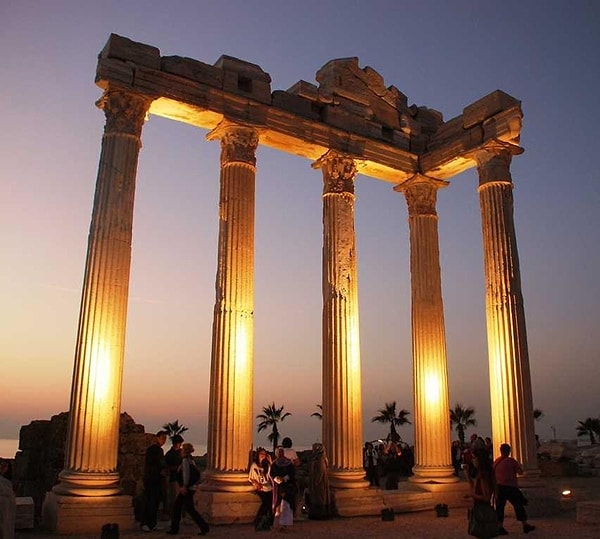
The ancient city of Side, which dates back to ancient times and was ruled by many emperors, is one of the most important places in the region. In the past, the people of the region living here spoke a language known as 'Sidece'. Although it is not yet known what the origin of this language is, it is accepted that it is originally a language of Luwian origin. Sidece is recognized as one of the Indo-European languages.
History of Side Ancient City
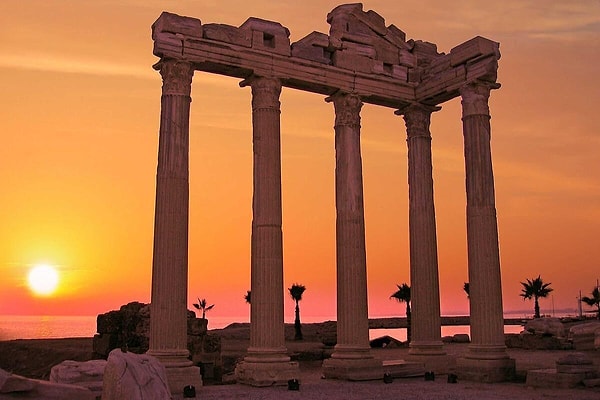
The symbol of the city of Side is the 'Pomegranate' because the word 'Side' means 'Pomegranate' in the Anatolian language. Based on information obtained from inscriptions, it is believed that the history of Side dates back to the Hittites. Another piece of information derived from inscriptions suggests that a unique language specific to Side was spoken until the 3rd century BC, and this language belonged to the Indo-European language family. This language is also known as 'Sidean' and is thought to have originated from the Luwian languages. It is rumored that the name 'Side' meaning 'Pomegranate' is associated with the legend of a pomegranate tree that gave the city its name.
The periods of Ancient Side City are dated to the 2nd century AD, and it is known as one of the five important cities in the Ancient Pamphylia region. As a natural harbor in the Pamphylia region, Ancient Side City was the only port in the region until the establishment of Antalya.
Ancient Side City is located 75 km east of Antalya and southwest of the Manavgat district. The city, situated on a peninsula, spans 1,000 meters in length and 400 meters in width. The earliest known settlement dates back to the 7th century BC when the Greeks established a colony on the peninsula. However, due to the fact that the word 'Side' meaning 'Pomegranate' is not Greek, it is believed that there was a settlement here even before the Greek colonization. Side City was conquered by various civilizations throughout its history, including the Lydians in the early 6th century BC, the Persians in 547-546 BC, Alexander the Great in 334 BC, the Ptolemies in the 2nd century BC, the Kingdom of Pergamon with the Peace of Apamea in 188 BC, the Roman Empire in 78 BC, the Seljuks in the 13th century, and the Hamitoğulları and Tekelioğulları in the 14th century. Side City experienced its most prosperous period as a trading center in the 2nd and 3rd centuries AD. It became a center of the Pamphylia region's bishopric in the 5th century AD. The city was burned and subsequently abandoned during the Arab invasion in the 7th century AD. It was revitalized under Seljuk rule in the 13th century and later settled by immigrants from Crete in 1895.
The theater in Ancient Side City is the only theater built on the largest columns in Pamphylia. The theater has a two-story stage building and a capacity of 17,500 people.
The Roman bath, found in Ancient Side City and dating back to the Roman period, has been transformed into a museum where the artifacts from Side are exhibited. Other ruins in the city, apart from the bath and the theater, include:
Roman Aqueducts
Libraries
Two Unique Temples
Ancient Harbor
Agora, Columned Street, and City Walls.
Where is Side Ancient City?

Side Ancient City is located in the Mediterranean region in the Manavgat district of Antalya. It is considered one of the important defense centers of the region with its magnificent view.
By car from Antalya to Manavgat city, you can reach the unique Side Ancient City, which has been under the rule of different rulers throughout history.
Side Ancient City Visiting Hours
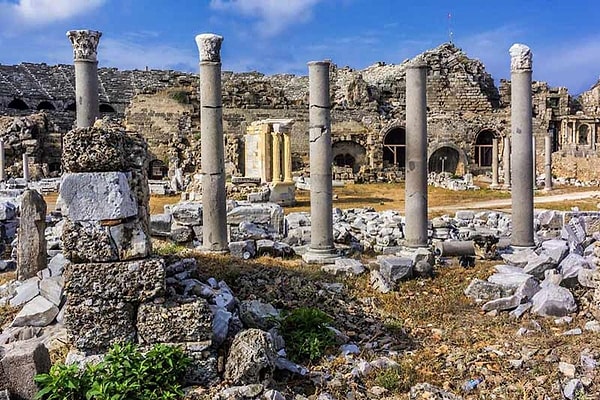
The ancient city of Side can be visited at different times, summer and winter. For this reason, it can be visited from 08:00 in the morning until 19:00 in the evening in summer. For the winter season, it can be seen from 08:00 in the morning until 19:00 in the evening again.
The Legend of Side Ancient City
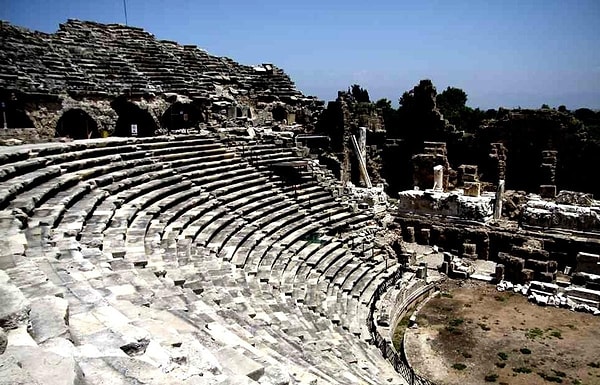
'Pomegranate' is known as the symbol of ancient goddesses representing the region in Anatolia. In this regard, the ancient city of Side, with its various temples, is also known as an important place of worship. It also has a unique language that has not been fully deciphered yet, known as 'Sidean'.
The story of the goddess Side, who transforms into a pomegranate tree, goes as follows: According to the legend, Side is the daughter of Toros (Taurus), the mountain god known as the nature and fertility goddess in Anatolia. One day, the goddess Side walks along the shore of the Melas (Manavgat) River with her daughter and the forest nymphs (fairies). In this enchanted place where they sing and dance, the goddess Side gently plucks a branch from a tree that she cannot resist for her daughter. Suddenly, when blood drips from the tree, she becomes scared and saddened. While experiencing these emotions, she tries to escape but realizes that her feet are rooted in the ground. And in the place where she can never move again, her body turns into a tree, with her bark hardening. Side realizes that the tree from which she plucked the branch is actually a goddess who transformed herself into a tree to protect herself from evil. She sheds tears and says, 'From now on, I will be a tree that bears fruit the color of blood. Bring my daughter to me often, let her play in my shade. But tell her never to pluck flowers again or harm trees.'
Side Ancient Theater
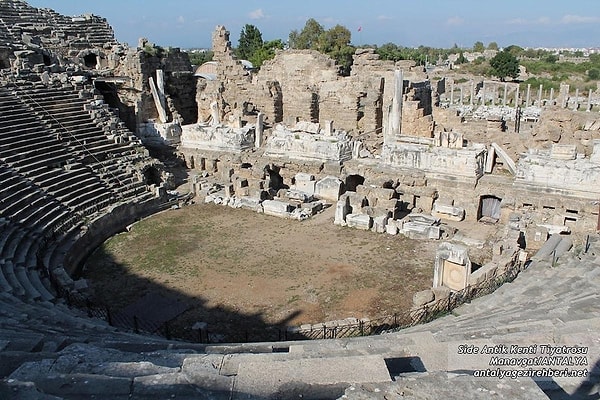
Side Ancient Theater, located in the center of Side Ancient City, was built in the tradition of Roman architecture. The section of the theater from the seating steps to the road in the middle of the steps leans against a hill. The upper part of the seating steps is designed with slopes on vaults and is made to conform to the plane. Thanks to this feature, Side Ancient Theater is the only example of its kind in Anatolia. This structure, which has a three-story stage building, stands out with its decorations in the Baroque style of the Antonine Period. Side Ancient Theater shares architectural similarities with the Colosseum. There are documents stating that the theater, with a capacity of 17,000 people, was used for gladiator fights and animal shows during the Late Roman Period. Admission to the theater is subject to a fee, and the Museum Card is valid.
Side Ancient City Apollo - Athena Temple
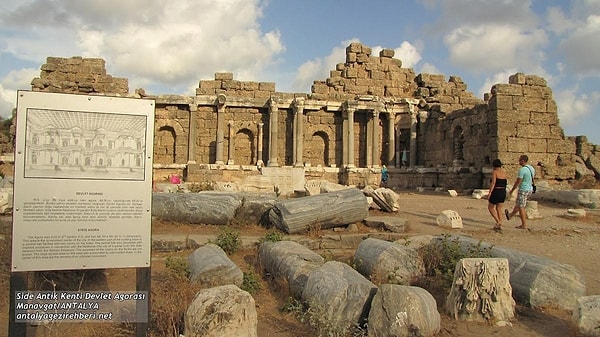
The Temples of Apollo and Athena in Side attract attention with their majestic presence, reaching out to the sun and sky, and continue to captivate people from different cultural backgrounds.
Historical Background of the Temples of Apollo and Athena
The residents of the ancient city of Side honored the god Apollo and the goddess Athena with the title of the founding deity 'Arkhegetes'. In addition to being the founding god, the epithet of Sidetes, defined by the historical evidence obtained from inscriptions and coins, refers to the symbol of the ancestral deity 'Patroos', which highlights another aspect of Apollo.
The god Apollo and the goddess Athena (known as Side Athena) are recognized as Anatolian deities originating from the ancient Anatolian cult traditions, as emphasized in various historical documents. The milestones of the transition from the concept of a mother goddess to the notion of divine beings in Anatolian belief system can be seen in the Anatolian Apollo Cult. In this belief system, Apollo is a symbol of the fusion of male and female power, earth and water, reward and punishment, archery and medicine. The fact that Athena's sacred fruit is the 'pomegranate', which is considered a symbol of abundance in Anatolia, and the presence of this detail in some statues, confirms its Anatolian origin.
Side Ancient City Monumental Fountain
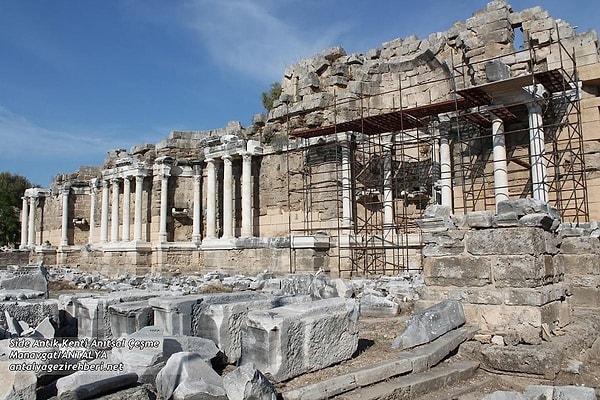
The Monumental Fountain located in front of the entrance gate of the Ancient City of Side is a Roman-era masterpiece dated to the 2nd century AD. It is considered the largest and most magnificent fountain in Anatolia and the Pamphylia region, and even today, it withstands the test of time and conditions.
Architecture of the Monumental Fountain
The fountain consists of three wide arches with semi-circular domes carved into the walls, supported by twenty-one columns, and has three stories with a front pool. The Monumental Fountain is adorned with marble-clad surfaces, relief sculptures, fish and Medusa heads on the columns, grooves between the columns, ceiling panels, embossed dolphin patterns, and acanthus leaf ornamentation. Only one story of the Monumental Fountain has survived to the present day. Some of the decorations and statues of the structure are exhibited in the Side Museum. The historical fountain, also known as the 'Nine Fountains,' received its life-giving water from the Manavgat Aqueduct, one of the most important natural structures in its location.
Side Museum
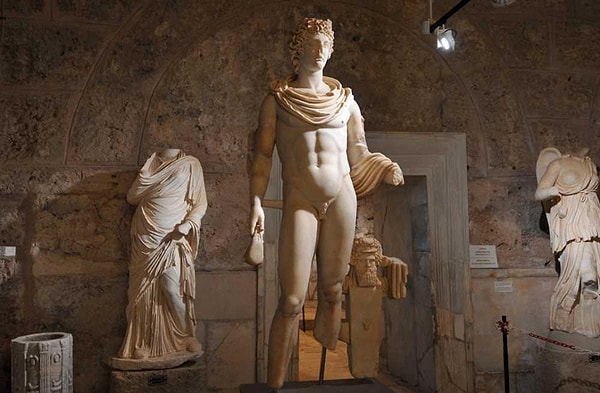
Side Museum is a restored historical structure located at the entrance of Side. Situated within the historical building known as the Old Quarter in Side Mahallesi, Manavgat district of Antalya province, the Side Museum is not only one of the most important museums in our country but also holds the distinction of being the first museum established in Turkey. When you first arrive at the ancient site of Side, after the famous Monumental Fountain that greets you, you will reach the Side Museum located on the right side of the Columned Street through the Main City Gate.
History of Side Museum
The Side Museum was converted from a part of the Agora Municipal Baths complex, which was built during the Roman period in the 2nd century AD in the ancient city of Side. The complex was restored and transformed into a museum. The present-day Side Museum was established in 1962. The old baths, which were originally constructed in a rectangular shape consisting of five main sections, were partially covered and the other two sections were arranged as open-air exhibition halls, contributing to our cultural heritage. These restoration works were carried out by the architect couple Selma-Ragıp Devrez.
About Side Museum
Side Museum exhibits a majority of artifacts from the Late Hittite, Hellenistic, Roman, Seljuk, and Islamic periods. The artifacts are displayed in enclosed halls, open-air areas, and gardens. They mostly consist of findings and artifacts unearthed during the excavations conducted in Side between 1947 and 1967 by Prof. Dr. Arif Müfid Mansel and his team. Mansel is also the founder of Side Museum. The exhibited items include inscriptions, relief carvings, replica sculptures of Greek originals from the Hellenistic and Roman periods, sarcophagi, osteoteks, amphorae, portraits, altars, tombstones, torsos, column capitals, and column bases.
Keşfet ile ziyaret ettiğin tüm kategorileri tek akışta gör!


Send Comment